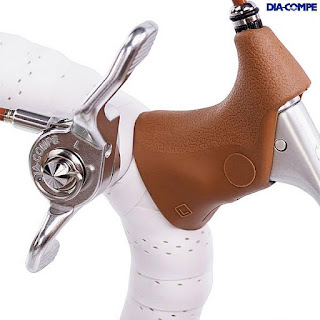I've got a bike-y confession to make.
The shifters on both of my bikes are these simple and inexpensive Gevenalle shifters. They're available for single, double, and triple chainrings, and cassettes through eleven speeds, and for short-pull brakes (for the caliper brakes on most of our road bikes), long-pull brakes (for the caliper and vee-brakes on many mountain and cyclocross bikes), and hydraulic brakes.
The shifters are friction for the front derailleur, and index or friction selectable for the rear. My confession is that I've been using friction shifting, front and rear, on both bikes, and I don't think I'm going back to index. There's less fussiness necessary about the derailleur adjustment, and I have to pay just that little bit more attention to how the bike is behaving while I'm on it... which is not a bad thing.
Racers apparently need index shifting to ensure that the shift goes in exactly when planned, because fractions of a second count for them. But on the rides on which I go, fractions of an hour sometimes go by unremarked. We have stops for pictures, for wardrobe adjustments, for conversation, for food... there is no need for such precision. The shifters I have serve my purposes well, and I don't think any of the people with whom I ride complain that my bike or its appurtenances are hindering our progress. (I may bring other qualities to the ride that hinder progress, but the bike is not one of those factors.)
But a new bit of flashy metal has caught my eye.
That piece of hardware loveliness is the newly-available Dia-Compe ENE wing shifter. It mounts inboard of, and behind, your single-purpose brake lever. It will manage up to eleven speeds in the rear... and it's only available in friction shifting.
The set of shifters is about $200. A set of brake levers can be had for about $35, which makes the controls more expensive than the Gevenalle controls (at $200 for the combined brake-shifter unit), but less expensive than most other eleven-speed controls.
And it's a beautiful thing, that displays the workings of the mechanism, as most modern bike controls do not. One of the things I love about my bikes' cable workings is that the mechanicals are all visible; as I engage the brake, for example, the cable can be seen to move, and the brake housing changes position slightly in response to the increased tension. The friction shifter shows how the cable wraps around the barrel, tightening or loosening so that the derailleur can guide the chain onto the next gear. It's all visible, and beautiful. It's like watching a dancer's rippling muscles.
The ENE wing will do the same thing, with the added advantages of shiny silver metal, and rarity. I'm smitten. I don't have an excuse to put it on any of my bikes (and by the time I DO have an excuse, it may be out of production; such are the vagaries of the velo industry). But if I were building up a bike for pretty...
I wonder if I can talk The Excellent Wife (TEW) into relaxing the rule about the next bike*?
*The rule is, if I get another bike, I've gotta buy another house with a two-car garage (or three-car sometimes; the rule is not fixed) and a better kitchen... so my next bike costs me a mortgage.


No comments:
Post a Comment